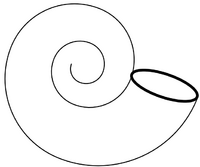Science:Math Exam Resources/Courses/MATH102/December 2013/Question C 01
{{#incat:MER QGQ flag|{{#incat:MER QGH flag|{{#incat:MER QGS flag|}}}}}}
• QA 1 • QA 2 • QA 3 • QA 4 • QA 5 • QA 6 • QA 7 • QA 8 • QB 1 • QB 2 • QB 3 • QB 4 • QB 5 • QB 6 • QB 7 • QB 8 • QC 1 • QC 2(a) • QC 2(b) • QC 2(c) • QC 2(d) • QC 3 • QC 4 •
Question C 01 |
|---|
|
A mollusc grows inside a shell and produces new shell material at its opening (indicated in the image below in bold) The volume of the shell can be approximated as that of a cone of base radius r and height h. Given that the height of the cone grows at a constant rate of 0.1 cm/year, at what rate will the volume of the cone be changing when and cm? Leave your answer in terms of . Note that: |
|
Make sure you understand the problem fully: What is the question asking you to do? Are there specific conditions or constraints that you should take note of? How will you know if your answer is correct from your work only? Can you rephrase the question in your own words in a way that makes sense to you? |
|
If you are stuck, check the hints below. Read the first one and consider it for a while. Does it give you a new idea on how to approach the problem? If so, try it! If after a while you are still stuck, go for the next hint. |
Hint 1 |
|---|
|
What relationship between r and h can we infer by similar triangles? |
Hint 2 |
|---|
|
Since we are only given the rate of change in the cone's height, try expressing the volume of the shell (cone) entirely in terms of h. |
Hint 3 |
|---|
|
Differentiate with respect to time to relate the rate of change in volume to the rate of change in height (note that both are functions of time). |
|
Checking a solution serves two purposes: helping you if, after having used all the hints, you still are stuck on the problem; or if you have solved the problem and would like to check your work.
|
Solution |
|---|
|
The volume of a cone is given by By the physical application of the problem, we can assume that the base radius of the cone changes as the height increases. First, we should express the radius of the cone as a function of its height. By similar triangles, and the fact that r = 1 when h = 10, we find that the following relation holds:
The rate of change in the volume of the cone can be computed by differentiating V with respect to t, giving us
|
{{#incat:MER CT flag||
}}











